Template:Realworld

On the occasion of Star Trek: The Next Generation first season finale, "The Neutral Zone", the producers were mindful that the re-introduction of the Romulans in the franchise needed to be memorable, with a likewise memorable ship, in scene 51a of the script simply referred to as "Romulan cruiser", to go with it. This was made even more important to the producers after the introduction of the Ferengi, intended as the new main antagonists, earlier in the first season, failed to make an impression. What ultimately was come up with was a powerful Romulan vessel, designated as the D'deridex-class.
Design
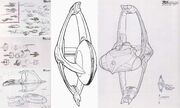
Trying to find a direction for the new Romulan warbird
The D'deridex-class warbird was the last new ship designed by Andrew Probert for the show, his design sketch of 21 March 1988 receiving the approval of the producers. (The Art of Star Trek, p. 83) On his design, Probert later remarked:
"The Romulan Warbird from the original series had, of course, a bird design on it. And I wanted to stay with that in someway. So, I started with bird and bird wing shapes. And eventually came to a design similar to what is on the screen. But my concept was to have one engine above and one below, because I felt that having a vertical design alien ship in front of the Enterprise, which has a very horizontal configuration, would be a nice contrast of ships.
"Now, Gene dictated that there are no three-engine starships and no single-engine starships [...] And then I started thinking that, back in World War II, all the nations that had fighter aircraft and airplanes did the same thing: they took off, they flew, they landed, they maneuvered. They usually had one engine, two wings, two tailwings – so they all had the same components, but they all looked different. There was a national design bias to each aircraft, but technically they all did the same thing.
"So my thinking was in Star Trek – since the Enterprise used to have two engines – I came up with the idea that the engines had to reach out to each other in order to work co-dependently. In other words, there would be no obstructions between the engines to disrupt the energy fields or connecting forces between them. And, well, all the alien ships could look different but still operate in the same principle. So that's why [...] [for] the Romulan Warbird, the engines would see each other through the ship. The ship is built above and below the energy field of those engines.
"But my original concept would be that there was a lot more ship, a lot more structure, packed inside those wings. So it was, looking like two big wing sections, obviously big enough to contain people and cargo. But my original concept had them bigger." Template:Brokenlink
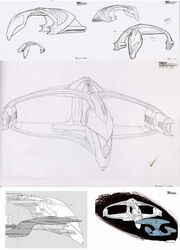
Probert's finalized sketches for the warbird
Experimenting with the vertical design concept, Probert further elaborated on his design process, "I didn't have any information except that the Romulans were coming back and that we had never seen their ship before [In TNG]. Since the Enterprise is so horizontal, I wanted to contrast it with a vertical ship. At this point we didn't see Gene Roddenberry anymore. Gene had always been open to suggestions. I was in awe of how he had created the show, and my respect for him was enhanced by the fact that he would sit and listen to your ideas. He may not have always used them, but he would always listen. I felt that if I had shown him the vertical warbird and explained my reasoning, he would have considered it. But that didn't happen." However, Probert was was told by another producer, "Let's make it horizontal instead". "So I created new preliminary drawings, and being that it was a war bird, I continued the birdlike motif from my earlier sketches." Conceding to the request, Probert also proceeded to add a bottom wing to his now horizontal design. Continuing, he further clarified, "I hadn't thought about putting a bottom wing on there, but I looked sideways at one of my earlier vertical drawings and thought I'd add a loop to see how that worked. I drew that final image as a scale reference to the Enterprise, just to show the difference in size. I love even numbers, so the warbird is 4,440 feet long. The thing is, I provided this image to the producers purposely to suggest that the scene be filmed with the Enterprise in front, obviously closer to us, yet the warbird is still larger. Unfortunately the visual effects people reversed the shot and you really had no idea how much larger the Romulan ship was." (Star Trek: The Next Generation 365, p. 132)
In 2010, Probert revisited his vertical orientation design when he produced a more detailed painting for the March spread of the Star Trek: Ships of the Line (2011) calendar. [1](X)
Physical studio models
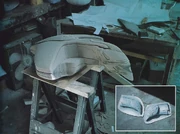
The foam master and first molds (inset) taken from it
The original studio model was made of cast resin and acrylic plastic. Built by Greg Jein in the month following its design approval, it measured 36×25×10 inches, debuted in "The Neutral Zone", and was last seen as stock footage in the Star Trek: Deep Space Nine episode "By Inferno's Light". Jein noted on the build, "I enjoyed working on the Romulan ship, because it was such an unusual shape. We did that pretty fast. Again, we, because it was such an unusual shape, we had to carve that out of flores foam and we vacuformed on top of that and we take the foam out, so we had a hard shell, so we could put the armatures and lights in." (TNG Season 4 DVD-special feature, "Select Historical Data") Years later, in 2012, he added in little more detail,
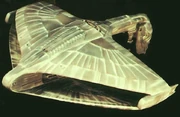
|
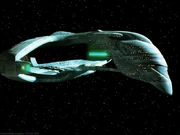
|
"And then in the final episode of the season, we got to see the Romulans come back, and Andy had this really strange design. And, again, we had like only three weeks to do it. So we had to carve out some shapes out of foam, vacuform a template to give us a hard skin that we could detail, throw it into a mold, pull the pieces out, and drill thousands of little fiber optic holes to get the lightings self contained." (TNG Season 1 Blu-ray-special feature, "Stardate Revisited, Part 3: The Continuing Mission")
The appearance of the D'deridex-class model has caused some confusion in regards to the color scheme. Well-known early publicity stills, especially in the 1980s Starlog Press publications, showed the model both in a green-gray color scheme and a metallic blue-gray color scheme (in particular to represent ships of the Tal Shiar, most notably in the Deep Space Nine episode "The Die is Cast"). This was partly due, in the case of the first one, to "tweaking" the colors in post-production editing.
The second filming model
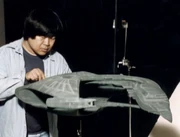
|
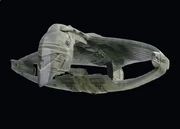
|
However, as it turned out, the other explanation for this was that the studio had two models made, the green and best known being the original, first one, and that they used them both. [2] Co-built, again at Jein's modelshop, by model maker Bruce MacRae, and almost identical to the original studio model, the second, blue-gray model differed from the green one in that, apart from the color, it had an additional feature added on the outer sides of the warp engines and it debuted in The Next Generation third season episode "The Defector", appropriately designated as "B-type" by Jean-Luc Picard in the episode, scene 52. It is not clear why the second model was commissioned, though Daren Dochterman has given a possible contemporary explanation; "On other occasions, it's done to give an in-house model crew something to do to justify billing the production company for it...and to maintain its existence." [3]
It was the second, blue-gray model, that was included, as Lot 702, in the 40 Years of Star Trek: The Collection auction, estimated at US$8,000–$12,000, where it was sold at auction on 7 October 2006 for a winning bid of US$30,000 ($36,000 including buyer's premium). It was sold to British collector Adrian Hancock, the same collector who had also managed to acquire the USS Voyager and USS Enterprise-C studio models in the action. [4] In a run up to the auction, making its only public appearance, the model was on tour at the Creation Convention in Las Vegas from 17 August to 20 August 2006. [5]
As of 2012, the whereabouts of the first, original, green-gray, model are unknown, presumably still in the possession of Paramount Pictures, though no sightings have been reported since.
Other physical models
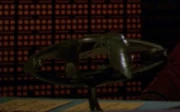
The Decius display model
In The Next Generation fourth season episode, "Future Imperfect", a display model could be seen aboard the Romulan Warbird IRW Decius. The model was an otherwise unmodified piece from the AMT/Ertl model kit No. 6858. This constituted the only time an alternative model was used to physically represent the class in any of the live action productions.
A limited production run of twelve, built from the same molds as the original studio model, but without internal lighting, was later sold in 1997, accompanied with a certificate of authenticity signed by Greg Jein at the Viacom Entertainment Store in Chicago, sporting yet another slightly differing color scheme, gun metal blue-gray, and without the extra detail on the warp engine assembly. Template:Brokenlink
CGI models
| File:D'dereidex class vessel engaged by USS Prometheus.jpg | 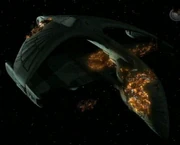
|
For the later seasons of Deep Space Nine and Star Trek: Voyager, a CGI model was constructed at Foundation Imaging. The model was built on the occasion of Voyager's fourth season episode "Message in a Bottle", as visual effects supervisor for that episode, Mitch Suskin, clarified, "We built the Romulan ship as a digital model for that show. That was done at Foundation. It was the first time the Romulan ship was built as a digital model." (Cinefantastique, Vol. 30, #9/10, p. 80). The first, green-gray model was used as reference, so the variant with the additional detail on the warp engine assembly was initially no longer seen from then on.
That was until Deep Space Nine's final season episode, "The Changing Face of Evil", when a close-up of a severely damaged warbird was needed. Foundation's model was modified at Digital Muse to showcase the damage and the modeler at Muse made use of the opportunity to add the extra nacelle detail and color-correct the model to resemble the second physical studio model.
Foundation Imaging's version of the CGI model made a few appearances in licensed print publications, most notably the Star Trek: Ships of the Line calendars and their book derivative, whereas Digital Muse's version was, in a to green reverted version, represented in the, by Bonchune co-authored, book Star Trek: Starship Spotter.
Derivative ship class studio models
| File:Mazarite warships.jpg | 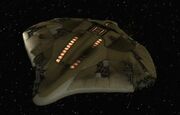
|
A somewhat curious re-emergence of the D'deridex-class design occurred with the appearance of the Mazarite warship in the Star Trek: Enterprise first season episode, "Fallen Hero". The design originated from a kitbash of a D'deridex-class AMT/Ertl model kit, No. 6858, by Dan Curry, using the upper wing structure to be "sold" to the producers for use in the new television series. The producers "bought" the design, and the prototype model was subsequently recreated as a CGI model at Foundation Imaging by Koji Kuramura and rendered by Robert Bonchune. When Bonchune was asked about this for his blog(X), Doug Drexler reported, "The Mazarite Attack Ship was always a puzzler. Why? How? It’s immediately recognizable as derived from Probert’s iconic Romulan Warbird. Not that Trek isn’t known for getting multiple uses from it’s motorpool. What makes it so noteworthy that this one of the only times a highly recognizable hero ship was recycled in such a manner. A hall of fame head scratcher for sure. I finally asked Rob Bonchune what that was all about, and he shrank in his chair. Was it a money saving deal? I asked. No, answered Rob. If we had chopped the Romulan Warbird model that would have been true. I screwed up my face. You mean this ship was built from scratch.. from the ground up? I kid you not, said Rob. Dan Curry brought in a section of the Warbird he’d liberated from an AMT model with instructions to custom build a new ship from it. It was plain that Rob was just as befuddled by the choice as I was.", to which Kuramura has added, "I’m pretty sure I built it from drawings...but it was a while ago. So I could be wrong." This CGI model was later, unmodified, reused as the Illyrian starship seen in the later third season episode, "Damage". This was one of the very few times that a design feature of a signature "hero" ship was recycled to represent an alien design.
